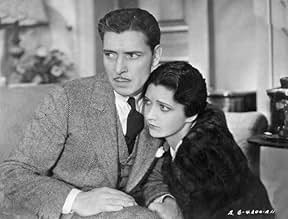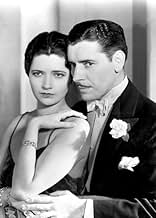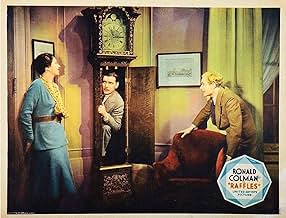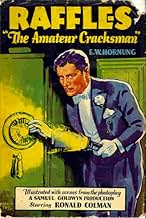Raffles
- 1930
- 1 h 12 min
Adicionar um enredo no seu idiomaA distinguished English gentleman has a secret life--he is the notorious jewel thief the press has dubbed "The Amateur Cracksman". When he meets a woman and falls in love he decides to "reti... Ler tudoA distinguished English gentleman has a secret life--he is the notorious jewel thief the press has dubbed "The Amateur Cracksman". When he meets a woman and falls in love he decides to "retire" from that life, but an old friend comes to him with a predicament that entails him com... Ler tudoA distinguished English gentleman has a secret life--he is the notorious jewel thief the press has dubbed "The Amateur Cracksman". When he meets a woman and falls in love he decides to "retire" from that life, but an old friend comes to him with a predicament that entails him committing one last job.
- Direção
- Roteiristas
- Artistas
- Indicado a 1 Oscar
- 2 vitórias e 1 indicação no total
- Lord Harry Melrose
- (as Frederic Kerr)
- Lord Melrose's Butler
- (não creditado)
- Harry - Lord & Lady Melrose's Friend
- (não creditado)
- Gwen's Friend
- (não creditado)
- Party Guest
- (não creditado)
- Direção
- Roteiristas
- Elenco e equipe completos
- Produção, bilheteria e muito mais no IMDbPro
Avaliações em destaque
Ah, but it stars 'The Voice', Ronald Colman, and that makes all the difference. Colman and his mellifluous voice glide through every scene and anesthetizes an unbelievable story just by talking. Here he was at the height of his popularity as the dashing cricketer/thief and has as his leading lady Kay Francis, one of the loveliest stars of that era. She is unfortunately given little to do in a meager role as his fiancé. But there are some other Hollywood stalwarts in the cast, among them Alison Skipworth in one of her ditzy socialite roles and silent film bad guy David Torrence, a Scotsman with a thick Scottish accent, as the investigating detective. Also Bramwell Fletcher and Frederick Kerr, a very elderly gentleman I found delightful in "Waterloo Bridge (1930)" in the same blustery, old duffer-type role.
"Raffles" is uncomplicated and good fun, and about as deep as a dish of water, but worth your time to see and hear Colman say things - doesn't matter what, just listen to him talk. Thank TCM for dusting this one off.
Moreover, as another character chimes, one, indeed, can't help liking Colman's Raffles. The supporting cast is decent, too, including Kay Francis as the romantic interest, David Torrence as the Scottish Scotland Yard inspector, and Alison Shipworth and Frederick Kerr are amusing as the bickering hosts to their home of guests spending the weekend, apparently, smoking, drinking and playing cricket and tennis--the sort of upper-class soirées one might expect from an episode of "Downton Abbey," where dandies in tuxedos sip brandy and retort that Americans are too savage to understand cricket.
I think what raises "Raffles" above many other early talkies, however, is the talent Samuel Goldwyn assembled behind the scenes, namely cinematographers George Barnes (5-time Oscar nominee) and Gregg Toland (who also photographed the 1939 version and is most famous for "Citizen Kane" (1941)) and art directors Park French and William Cameron Menzies (the latter of whom would invent the job of production designer during the making of "Gone with the Wind" (1939)). There's nothing amateurish in their design of the amateur cracksman's first heist scene, with the policeman's shadow lurking in the background behind store-front glass as a safe is cracked with the aid of a diegetic light source. Some camera movement is managed, too, including a nice shot of Colman on the staircase upon seeing Francis's entry. Being England, there's also a fog-filled sequence. There's nothing amazing about any of this, but it's worth noting how much difference to a slight scenario burdened by primitive new technology can benefit from skilled artists behind the camera while placing charming actors in front of it, as well as giving some thought to how to use and not use the newfangled sound.
Raffles is a British gentleman who supports himself by being a jewel thief - an amateur cracksman. The film opens with his burglary of a jewelry store with him leaving a calling card saying that this is his final burglary. He's fallen in love with Gwen (Kay Francis) and plans to leave this life behind because of his love for her. But then his friend Bunny appears, literally suicidal, and says he has written a bad check of one thousand pounds for gambling debts. His reputation will be ruined when the bank opens Monday morning and the check is known to be bad. So Raffles must pull one more job to help out his friend since he gave the jewelry in his last robbery to Gwen. He eyes the jewels of Lady Melrose as doing the job. Plus Bunny already has an invitation to go to the Melrose estate for the weekend for a big gathering that is going on there, so Raffles asks Bunny if he can go along. Realize that Raffles' criminal activity is a secret from everyone at this point - friends, family, servants.
But there are complications. Scotland Yard sends an inspector to the Melrose estate along with a cadre of cops because Scotland Yard thinks that the Amateur Cracksman will strike there that weekend. Also, there is a gang of burglars planning to steal the Melrose jewels themselves, under the cover of darkness. Then Gwen decides to pay a surprise visit to the Melrose estate, further complicating Raffles' plans to steal Lady Melrose's jewels.
I really can't say anymore without spoiling the fun for other viewers, but considering it is a very early talkie it is amazingly fluid and quite good at delivering suspense and comedy. Particularly amusing is Alison Skipworth as Lady Melrose. In her 50s, Melrose's heart still skips a beat around Raffles on who she obviously has a crush to the point that she talks about him in her sleep.
Dashing Ronald Coleman was unusual among silent cinema leading men in that his popularity was not diminished by the coming of sound. Many other leading men lost their popularity and their careers simply because they did not sound like what audiences expected. Colman had no such problem and with his excellent voice he was a natural with dialog. Watch this one and see what I mean. It delivers a great story well told, does not outstay its welcome, and supplies just the right amount of dialog.
In the 1939 version, maybe because of the code, Raffles is a Robin Hood type who robs for the excitement and fun of it but then helps someone in need with the money or returns the merchandise. In this version, he steals, period, and in fact presents Gwen with a bracelet from one of his crimes. This film skips the whole beginning of the '39 film showing Raffles' acts of kindness, but the rest of the story is the same. Raffles decides to retire and start life anew with Gwen, but his friend Bunny shows up with a gambling problem and needs to cover a 1000 pound check by Monday. Raffles, alas, needs to do one more job.
Ronald Colman is delightful as Raffles, dashing, charming, and handsome as he cleverly attempts to escape the clutches of Scotland Yard. It's a wonderful role for him, as it was for David Niven in 1939. Kay Francis is wasted but is a good match for Coleman.
Fun film with a fine performance by Colman.
Raffles the English gentleman has a discreet sideline as a burglar and jewel thief. The press has dubbed him 'The Amateur Cracksman', and as such he has become a household name. Now that he has fallen in love with the sophisticated Gwen (Kay Francis) and proposed marriage to her, Raffles has decided to retire from crime. However, his old pal Bunny is in a spot of bother. Bunny has been playing cards again, and has run up a gambling debt of £1,000. If Bunny is to be rescued from his predicament, Raffles will have to take on the Melrose 'job' ...
Ronald Coleman gives us his trademark suave Englishman in the title role. We see him burgling a jeweller's shop wearing a top hat (note the excellent Toland touch of the policeman silhouetted against the window drape). Our first real glimpse of the hero comes on the dance floor as he sweeps Gwen around in a romantic waltz. On the cricket field at Lord Melrose's place, Raffles is of course dashing, and wins the game (even though he was not supposed to be playing - he invited himself along for the weekend at the last minute). Even when Inspector Mackenzie has him on the ropes, Raffles remains the epitome of poise and wit.
"All bubbles and froth - no taste," says Lord Melrose, giving his verdict on champagne. It is a reasonable comment on the film itself, which for all its pretensions to style is basically an inelaborate crime flick. We have the 'two Englands' crudely juxtaposed - one urban and ugly (the cloth-capped burglars from the pub, the 'pea soup' fog in London) and the other bucolic and 'refayned' (Lady Melrose's soiree). The film takes it for granted that the lower classes are unpleasant.
However, there are good things in this movie. The cricket match is fun, and tolerably well done, though Raffles' bowling action is highly dubious and the umpire's position would make lbw decisions interesting to say the least. The skylight scene on Raffles' apartment roof is an arresting image.
There is also a large portion of baloney. Does Scotland Yard protect country houses against burglary? Is this best done by surrounding them with a dozen detectives throughout the night? Why don't these detectives catch the various burglars who enter the premises? If closing the sash window is enough to stop the burglar alarm from ringing, then it isn't much of a burglar alarm. The 'common' burglars crouch in the shrubbery and talk aloud, spelling out their plans in pedantic detail, conveniently allowing Raffles to overhear. Is it not slightly more probable that they would have worked out what to do before entering the property?
The film ends in a flurry of increasingly silly activity. Blatant undercranking of the camera makes Raffles' escape dash look ridiculous, and his place of concealment is laughable.
Verdict - An enjoyable crime caper with absurd elements.
Você sabia?
- CuriosidadesThe last Samuel Goldwyn movie to be shot simultaneously in silent and talkie versions.
- Erros de gravaçãoWhen the alarm goes off and the cat burglar is attempting to escape, Bunny's bedroom windows are show to be wide open, which would have prevented the alarm being set in the first place.
- Citações
Inspector McKenzie: Good heavens! In the tobacco! Well, I'll be...
A.J. Raffles: Yes, I thought that you would be.
- Versões alternativasRaffles (1930) was made simultaneously in silent and talking versions. With almost all the theaters in the USA wired for sound, this was to be the last film that Samuel Goldwyn produced in this manner.
- ConexõesReferenced in O Diabo é um Poltrão (1936)
- Trilhas sonorasThe Blue Danube
(uncredited)
Written by Johann Strauss
Heard when Raffles takes Lady Melrose to her room.
Principais escolhas
- How long is Raffles?Fornecido pela Alexa
Detalhes
- Data de lançamento
- País de origem
- Idioma
- Também conhecido como
- Herr Raffles gör visit
- Locações de filme
- Empresa de produção
- Consulte mais créditos da empresa na IMDbPro
Bilheteria
- Faturamento bruto nos EUA e Canadá
- US$ 1.000.000
- Tempo de duração1 hora 12 minutos
- Cor
- Mixagem de som
- Proporção
- 1.20 : 1
Contribua para esta página

































